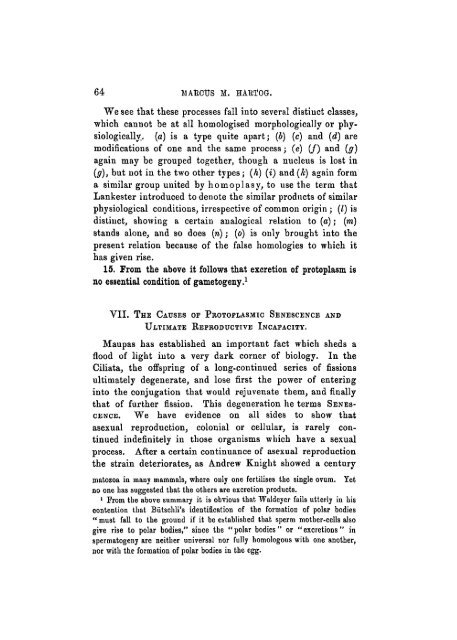Some Problems of Reproduction: a Comparative Study of ...
Some Problems of Reproduction: a Comparative Study of ...
Some Problems of Reproduction: a Comparative Study of ...
Create successful ePaper yourself
Turn your PDF publications into a flip-book with our unique Google optimized e-Paper software.
64 MAUCtJS M. HATJl'OG.<br />
We see that these processes fall into several distinct classes,<br />
which cannot be at all homologised morphologically or physiologically,,<br />
(a) is a type quite apart; (b) (c) and (d) are<br />
modifications <strong>of</strong> one and the same process; (e) (/) and (g)<br />
again may be grouped together, though a nucleus is lost in<br />
(g), but not in the two other types; (h) (i) and(k) again form<br />
a similar group united by homoplasy, to use the term that<br />
Lankester introduced to denote the similar products <strong>of</strong> similar<br />
physiological conditions, irrespective <strong>of</strong> common origin ; (I) is<br />
distinct, showing a certain analogical relation to (a); (m)<br />
stands alone, and so does (n); (o) is only brought into the<br />
present relation because <strong>of</strong> the false homologies to which it<br />
has given rise.<br />
15. From the above it follows that excretion <strong>of</strong> protoplasm is<br />
no essential condition <strong>of</strong> gametogeny. 1<br />
VII. THE CAUSES OF PROTOPLASMIC SENESCENCE AND<br />
ULTIMATE REPRODUCTIVE INCAPACITY.<br />
Maupas has established an important fact which sheds a<br />
flood <strong>of</strong> light into a very dark corner <strong>of</strong> biology. In the<br />
Ciliata, the <strong>of</strong>fspring <strong>of</strong> a long-continued series <strong>of</strong> fissions<br />
ultimately degenerate, and lose first the power <strong>of</strong> entering<br />
into the conjugation that would rejuvenate them, and finally<br />
that <strong>of</strong> further fission. This degeneration he terms SENES-<br />
CENCE. We have evidence on all sides to show that<br />
asexual reproduction, colonial or cellular, is rarely continued<br />
indefinitely in those organisms which have a sexual<br />
process. After a certain continuance <strong>of</strong> asexual reproduction<br />
the strain deteriorates, as Andrew Knight showed a century<br />
matozoa in many mammals, where only one fertilises the single ovum. Yet<br />
no one has suggested that the others are excretion products.<br />
1 From the above summary it is obvious that Waldeyer fails utterly in his<br />
contention that Biitschli's identification <strong>of</strong> the formation <strong>of</strong> polar bodies<br />
" must fall to the ground if it be established that sperm mother-cells also<br />
give rise to polar bodies," since the "polar bodies" or "excretions" in<br />
spermatogeny are neither universal nor fully homologous with one another,<br />
nor with the formation <strong>of</strong> polar bodies in the egg.

















